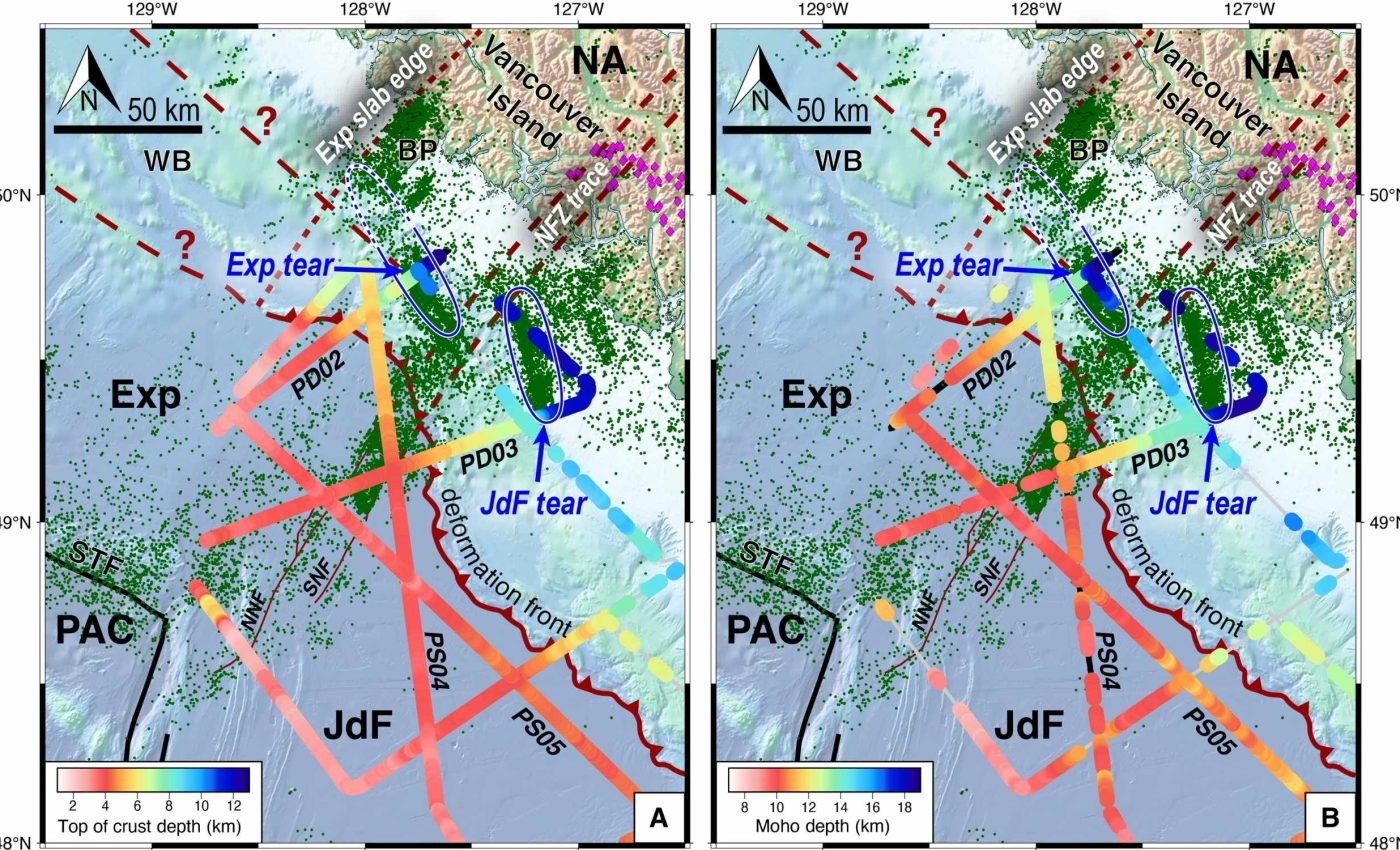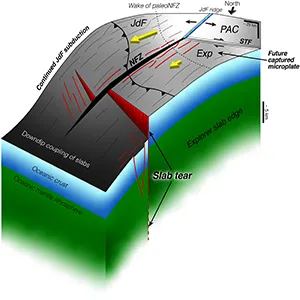
Earth's crust is breaking apart off the Pacific coast, and scientists are watching it in real time
Scientists have mapped a deep rip forming beneath the seafloor off Vancouver Island in the The Nootka Fault Zone (NFZ) of the Cascadia subduction margin.
A new study reports a trench parallel tear about 22 miles long that is starting to shut down a section of the subduction engine.
The team shows that a small oceanic plate fragment is peeling away while the neighboring plate keeps sinking.
That split location is offshore northern Vancouver Island, a place where three plate boundaries meet and grind.
NFZ and Cascadia subduction
The work is led by researcher Brandon Shuck of Louisiana State University (LSU), who specializes in marine geophysics.
His group combines ship based seismic imaging with detailed earthquake catalogs to capture the tear as it forms.
The break sits within the Nootka Fault Zone (NFZ), a transform system that separates the Explorer and Juan de Fuca plates in the the Cascadia subduction margin.
The fault zone, a boundary where plates slide past one another, organizes motion there into mostly sideways shear.
How a ridge meets a trench
To follow the story, it helps to pin down subduction, the process where one plate sinks beneath another into the mantle. That process builds mountains, recycles crust, and can drive very large earthquakes.
At the northern Cascadia margin, a spreading ridge approached the trench over millions of years.
A triple junction, the point where three plate boundaries meet, migrated along the coast while young, buoyant crust reached the subduction zone and began resisting the pull.
The new seismic profiles reveal a transform fault, a sideways sliding boundary, that narrowed from a broad shear band into a focused corridor about 12-miles wide. That corridor cut an oceanic microplate from its neighbor and slowed its descent.
Landward of the trench, the team images a sharp drop in the downgoing slab and a nearby buckled section.
These structures match two steep bands of earthquakes that run along the trench for roughly 22 miles, a pattern consistent with slab tearing.
From fabric to fracture
Seaward of the trench, the crust carries inherited ridge parallel cracks. The NFZ reactivated these features in Cascadia, creating a lithosphere, the rigid crust plus upper mantle, that was already weakened when it reached the trench.
As the small plate fragment rotated, stress focused near the NFZ. The result was a near vertical rip that slices the down-going slab from top to about 25 miles depth, with normal faulting concentrated along the tear plane.
On the Explorer plate side, subduction slowed to about 0.8 inches per year. On the Juan de Fuca side, subduction continued at roughly 1.6 inches per year, creating a speed mismatch that the NFZ exploited.
This mismatch also rearranged forces within the slab. Slab pull, the downward tug from a sinking plate, weakened on the torn side and shifted to its intact neighbor, steepening one slab segment while the other rebounded slightly.
Why the NFZ matters
The NFZ has long been recognized as a busy boundary that divides the incoming plates in the Cascadia region. Natural Resources Canada describes how it initiated a few million years ago when ridge geometry changed, creating a new plate fragment and a complex corridor of faults.
Independent work also shows the NFZ hosts dense swarms of small and moderate events and left lateral strike slip motion. That behavior is consistent with a transform system linking the ridge, the trench, and the continental margin.
The researchers argue that the tear first propagated along the trench, then was offset sideways by the NFZ. That geometry explains why the two earthquake bands sit about 12 miles apart across the boundary.
The team also sees a trench, the deep seafloor bend where a plate dives, that is pushed seaward on one side and pulled landward on the other.
That shape matches expectations when the torn slab segment stops helping to pull, and the intact segment takes up more of the load.

NFZ, Cascadia, and the future
If the tear finishes cutting through, a slab window, a hole in the sunken plate, will open beneath the margin. Hotter asthenosphere, softer mantle that flows slowly, can then move upward into that gap and alter heat flow and melting patterns.
The long view points to a shorter subduction margin by about 47 miles once the Explorer segment is captured by the Pacific plate.
The nearby triple junction would likely shift, and the corridor that is now a shear zone would strengthen into a simpler transform boundary.
This research does not change the known hazard from the regional megathrust. It does, however, sharpen the map of which parts of the slab are attached, how they bend, and where stresses concentrate.
Seeing the tear now allows modelers to test how ruptures might thread through a segmented system. It also shows how a ridge to trench encounter can end subduction in pieces rather than all at once.
The study is published in Science Advances.
—–
Like what you read? Subscribe to our newsletter for engaging articles, exclusive content, and the latest updates.
Check us out on EarthSnap, a free app brought to you by Eric Ralls and Earth.com.
—–













